
views
X
Expert Source
Steve Horney PT, MPT, MTC, CSCSLicensed Physical Therapist
Expert Interview. 3 June 2020.
Neck tension can often lead to tension headaches and other spine issues. You can reduce uncomfortable or painful neck tension by doing neck stretches, using massage and heat, and by adjusting your daily routine.
Stretches for Neck Tension
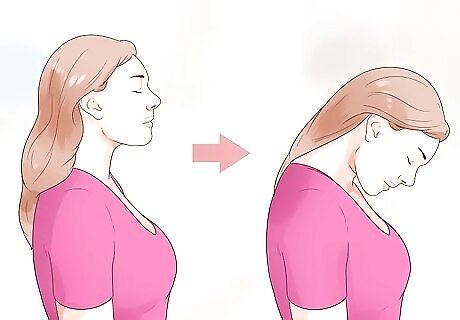
Tuck your chin in toward your chest. Gently lower your chin towards your chest. At the same time, imagine you're standing against a wall, and slide the back of your head up along that imaginary wall. When you sit in front of a monitor all day, the bottom half of your neck ends up flexed, but the top part ends up in extension so you can see the screen. To help relieve that, you need to have the top portion of your neck flexed forward, with the bottom part sitting over itself. Hold this stretch for two to three breaths. You should feel your neck muscles and your shoulder muscles lengthening. Inhale as you lift your head and return to the starting position. Repeat this exercise two to three times, holding for two to three breathes at a time.
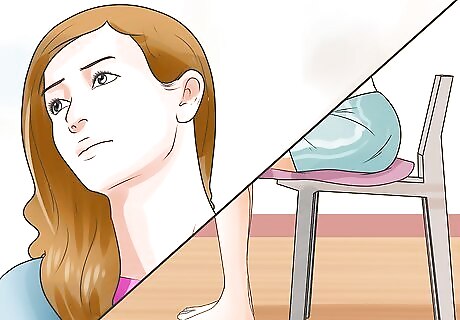
Combine chin tucks with neck tilts. Start by tucking your chin in toward your chest and lifting the back of your head. Then, inhale and tilt your head to the right side. Extend and elongate your neck towards the space to your right, rather than try to bring your ear to your shoulder. You should feel a stretch on your left shoulder and the left side of your neck. Hold this position for three breaths. As you exhale, raise your neck and look forward. Then, inhale as you tilt your head to the left side. Hold this position for three breaths. Neck tilts are a good way to start your neck stretching routine, as they will help to lengthen the larger muscles in your neck and relax your whole body. Lengthening and stretching the small muscles in your neck can also prevent tension headaches. Sit in a comfortable cross-legged position on an exercise mat or a soft surface. You can use props like a yoga block or a pillow and sit on them to make the seated position more comfortable. You can repeat this exercise two to three times on each side. You can also add some resistance by placing your hand against your head and gently applying pressure to your head as you tilt your head to one side. If you are tilting your head to the right side, for example, you would use your left hand to apply light pressure on the left side of your head. Do not pull or tug on your neck and only apply light, gentle pressure on your head.
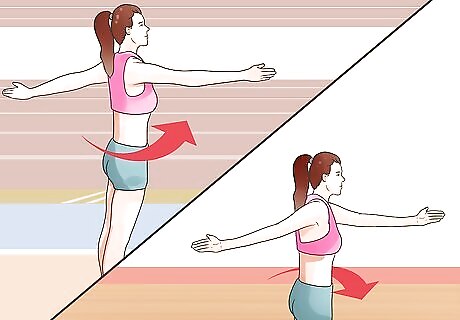
Try swinging arm stretch. This simple standing stretch will get your torso and arms moving and help to release any tension in your neck and shoulders. Begin in a standing pose with your feet hip width apart and your arms down by your sides. Start to swing your arms from side to side. Use your torso and your shoulders to turn your body gently from side to side, letting your arms also swing side to side. Swing your arms and body for six to ten breaths. You can also make your hands into fists and swing your arms so your fists land just about each hip. Repeat this for six to ten breaths.
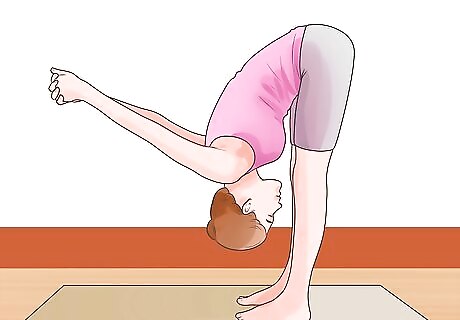
Do a forward fold with a chest opening. This standing pose is great for releasing tension in your neck and shoulders. Stand with your legs two to three feet apart on a mat. Turn your feet in so your toes are turned inward and your heels are turned slightly outward. Clasp your hands behind your back so your fingers intertwined and your palms are as close together as possible. Inhale as you lift your chest to the ceiling, with your neck facing upward. Exhale as you slowly bend forward between your legs, bending at your hips and not your lower back. Let your clasped hands raise up towards the ceiling and allow gravity to slowly let them fall over your head. Hold this position for six to eight breaths. Allow your head to hang heavy and continue to clasp your hands tightly together. You should feel a stretch on your neck and shoulder muscles.
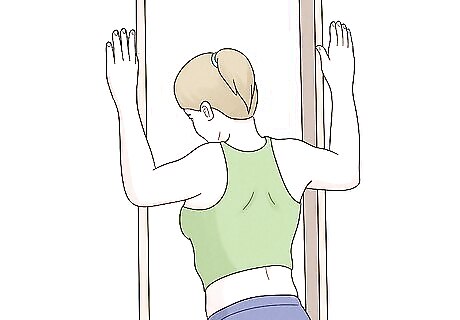
Use a wall to do a standing pec stretch. You can use the corner of a wall to help stretch your chest muscles and relieve any tension you are holding in this area. This will help your shoulders from rounding, which will put your neck into a better and more neutral position. Start by standing about two feet back from the corner of the wall, facing towards the corner. Keep your feet together and place equal weight in both feet. Place your forearms on each wall, with your elbows just below the height of your shoulders. Inhale and lean in as far as you can without feeling any pain. You should feel a stretch in your chest and the front of your shoulders. Hold the stretch for about six to eight breaths. You can repeat this stretch three to five times a day.
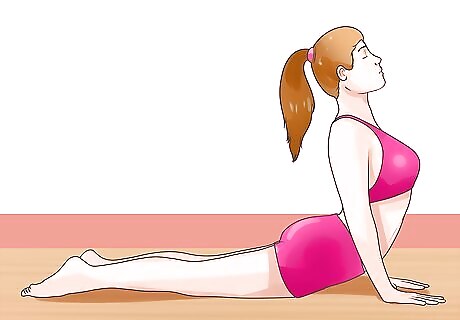
Do cobra pose to stretch and strengthen your neck muscles. Once you have warmed up your neck muscles with several opening stretches, you can try a cobra pose to strengthen your shoulder muscles, and your neck and upper back muscles. This pose can help improve your posture and your overall spine health. It is recommended that you stretch out tense neck muscles first before doing cobra pose. Begin by lying face down on a mat, with your forehead flat on the mat or resting on a thin towel for support. Your arms should be at your sides, with your palms flat on the mat. Place your tongue on the roof of your mouth, as this will help to stabilize your neck muscles. Inhale and squeeze your shoulder blades together as you lift your hands and arms, letting them hover a few inches above the mat. Lift your forehead about an inch off the mat with your gaze straight ahead and down. Hold this position for six to eight breaths, making sure your head is facing downward and you are putting weight into your legs and pressing your toes down on the mat. Repeat this pose again two to three times. Rest between each pose with one side of your head flat on the mat.
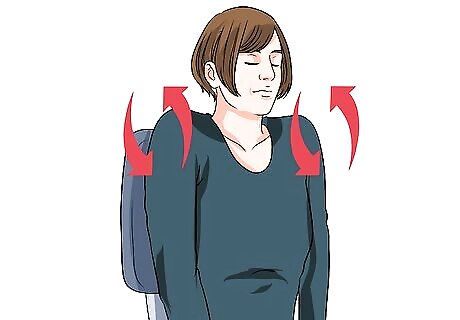
Try shoulder clocks. Shoulder shrugs work the upper shoulder and neck muscles. Sit in a chair or stand with your feet flat and shoulder width apart. Let your arms hang at your sides, then rotate your shoulders first clockwise, then counterclockwise. Repeat three to four times per day.
Using Massage and Heat
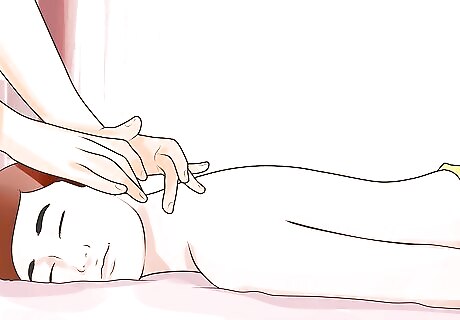
Massage the trigger points on your neck. Massage can help you to work out and release any tension in your neck muscles, especially if you tend to feel tension in the same spot on your neck. These trigger points are tight knots of muscle fiber that are stressed or strained. To give yourself a neck massage, start by using your thumb and forefinger to gently press on the muscles that line your neck and shoulder area, also known as the trapezius muscle, which stretches from the base of your skull down to the middle of your back and over your shoulder. You may feel multiple trigger points on your trapezius muscle. These trigger points will feel rope like and when you apply light pressure, you may feel discomfort spread throughout the muscle area. Use your thumb and forefinger or your knuckles to gently rub and knead out your strained neck muscles. If there is a coworker, friend, or partner nearby, you may ask them to help you rub and knead out the trigger points on your trapezius muscles. You can also get a professional massage done on your neck and shoulder muscles. Going for monthly massages can help to reduce neck tension and pain.

Use a foam roller to help massage your neck muscles. You can also use a foam roller to massage out your trigger points and release any neck tension. Foam rollers can be found at most exercise supply stores. Look for a full length, six inch diameter foam roll. Place the foam roll on the ground or on an exercise mat. Lie down on it lengthwise, with your upper back on the foam roll. You can place your hands on your hips or on either side of your body. Keeping your torso parallel to the ground, roll your upper back and scapular muscles sideways against the foam roller. You should start to feel tension releasing in any sore trigger points. Roll at least 20 times on each side of your body to release neck and shoulder tension. You can use the foam roller on a daily basis to help manage any muscle pain or tightness.
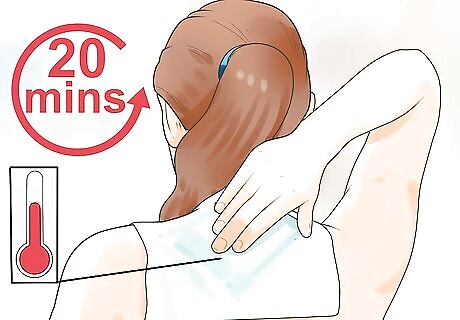
Apply a heat pack to your neck muscles. Heat can help to reduce pain and muscle spasms on your neck. Wrap the heat pack in a towel and hold it to your neck for 20 minutes at a time. You can also apply a cold pack wrapped in a towel on your neck as cold temperatures can also offer pain relief.
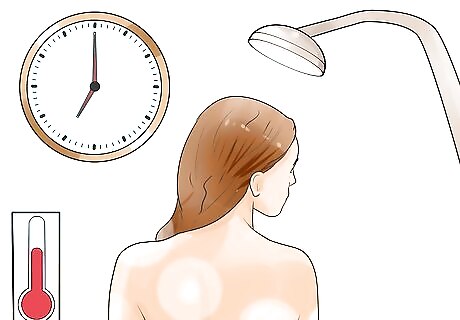
Take a hot bath. A long, relaxing soak in hot water can help to sooth any tense muscles in your neck and shoulders. Try to lay down on your back in the bath so your neck and shoulders can soak and relax in the hot water. You can also take a hot shower but make sure you stand in the hot water long enough for your neck muscles to warm up and relax. Try sitting on a small stool while letting the shower run down the back of your neck. You can perform your gentle neck stretches while sitting or standing in the shower. This allows you to stretch more while letting the hot shower warm up your muscles.
Adjusting Your Daily Routine
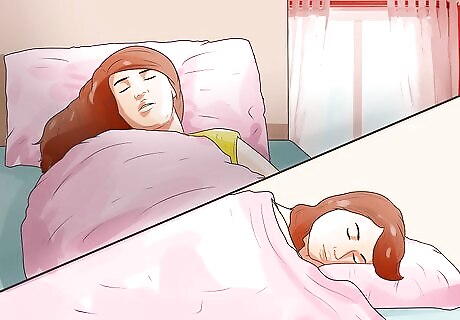
Sleep with your neck in a neutral position. Find a pillow that fits your body, and that keeps your head and neck neutral. Sleeping on too many pillows can cause your neck to bend unnaturally, which can cause neck tension. Try to sleep on only one to two pillows or get a cervical pillow, which are contoured to support your head and neck. These pillows also keep your neck aligned with your spine.
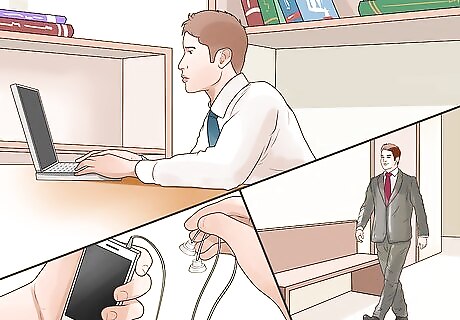
Adjust your posture when you are sitting for long periods of time. Neck tension is often caused by sitting in one position for long periods of time, usually when working on a computer or driving in a car for several hours at a time. Adjusting your posture in these stationary positions can help to reduce neck tension and improve your spinal health. When sitting at a computer, try to adjust your posture so your alignment is correct and you are not putting excessive stress on your neck muscles. Move your computer screen so it is at eye level on your desk. Test the setup of your computer by sitting in your office chair. Make sure your gaze is directly in the center of your computer screen. You should also try to keep your head in the center of your computer screen, rather than leaning to one side. You can also use a hands-free device, like a headset, if you talk on the phone throughout the day and do not want to have to hold the phone between your ear and your shoulder. If you are looking at any notebook or notes while typing at your computer, you can use a paper holder next to your computer screen. This will help you avoid keeping your head turned and down to one side while typing. Take breaks throughout the work day and move around every 20-30 minutes so your neck does not tense up or get stuck in one position. Check your eye prescription if you're having a lot of neck pain at work. If you're straining to see, you might be leaning forward throughout the day without realizing it.
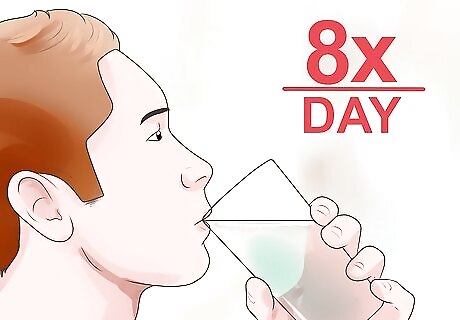
Drink lots of water throughout the day. The spinal discs that sit between the vertebrae of your spine contain mostly water. Sipping water throughout the day will ensure your body stays hydrated and your spinal discs remain healthy and fluid. Try to drink at least five to eight glasses of water a day.

Do at least 150 minutes of exercise a week. Getting your body moving through exercise at least once a day can help to alleviate tension in your muscles and strengthen your muscles so they are less likely to tighten up. If you are worried about injuring your neck with intense exercise, try light exercise like a gentle yoga class, swimming, or jogging. Never put undue stress on your neck if it is stressed or tense. Avoid contact sports if you are experiencing neck tension and neck pain, as well as more intense aerobics classes.

Take pain medication to help alleviate the pain. If your neck tension is causing discomfort that cannot be stretched out, you can take regular doses of pain medication like ibuprofen or paracetamol to control the pain. If the neck tension does not alleviate in several days or weeks, despite the use of painkillers and neck stretches, you should see your doctor. Your doctor will examine your neck and ask you questions about your daily routine to determine if your neck tension is the result of a more serious medical issue.














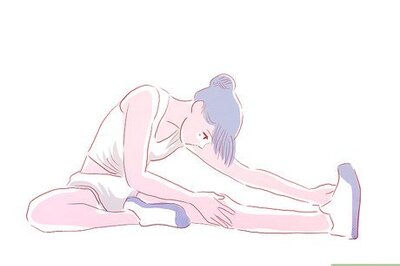



Comments
0 comment